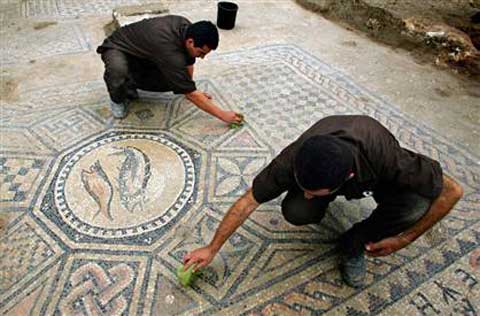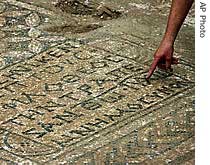2005 11 08
By Robert Berger | voanews.com

Israeli prisoners Rizlov Ramil, top, and Biton Maymon, bottom, clean a section of a Christian mosaic floor dating to the third or fourth century A.D., in the compound of the Megiddo prison in northern Israel. Image from: msnbc.msn.com |
The archaeological world is buzzing with news of a major find in Israel. The discovery is being hailed by Christian leaders, who see it as an affirmation of the faith.
Israeli archaeologists have uncovered the ruins of a third- or fourth-century church in northern Israel, which they believe could be the oldest ever found in the Holy Land. The church contains a well-preserved mosaic, with references to Jesus Christ and images of fish - an ancient Christian symbol.
"This find is once in a lifetime," Chief archaeologist Yotam Tefer told VOA. "It is very, very exciting."

An Israeli archaeologist points at a section of a Christian mosaic at an excavation site in the compound of the Megiddo prison in northern Israel, Sunday, Nov. 6, 2005 |
The church was found during renovations at a prison in Megiddo - what the New Testament calls Armageddon - the site of the final apocalyptic war marking the end of the world.
"This is the place, the site of the last battle, Armageddon," said Mr. Tefer. "Of course, this is the place. So, this is why it's so important to the Christian world."
Word of the find has electrified the Christian world.
"Surely it is a great discovery, which will be a confirmation for all the Christians all over the world," said Pietro Sambi, the Vatican's ambassador to Israel, told Israeli television.
"Of course, all the Christians are convinced of the historicity of Jesus Christ," he added. "But it is extremely important to have archaeological proof of a church dedicated to Him."
It is also good news for the Israeli tourism industry, which has been battered by five years of Israeli-Palestinian fighting.
"This find made my heart palpitate!" said Israel's tourism minister, Avraham Hirschzon. "It could bring a very large flow of tourists to the country," he said. Israel is considering moving the prison where the church was found, so it can open the site to the public.
That would enable Christian pilgrims visiting Jerusalem, Bethlehem and Galilee, to include a stop at Armageddon.
Article from: http://www.voanews.com/english/2005-11-06-voa20.cfm
Archaeologists unveil ancient church in Israel
By The Associated Press | msnbc.msn.com
MEGIDDO PRISON, Israel - Israeli prisoner Ramil Razilo was removing rubble from the planned site of a new prison ward when his shovel uncovered the edge of an elaborate mosaic, unveiling what Israeli archaeologists said Sunday may be the Holy Land’s oldest church.
The discovery of the church in the northern Israeli town of Megiddo, near the biblical Armageddon, was hailed by experts as an important discovery that could reveal details about the development of the early church in the region. Archaeologists said the church dated from the third century, decades before Constantine legalized Christianity across the Byzantine Empire.
“What’s clear today is that it’s the oldest archaeological remains of a church in Israel, maybe even in the entire region. Whether in the entire world, it’s still too early to say,” said Yotam Tepper, the excavation’s head archaeologist.
Israeli officials were giddy about the discovery, with Prime Minister Ariel Sharon calling the church “an amazing story.”
Vatican officials also hailed the find.
“A discovery of this kind will make Israel more interesting to all Christians, for the church all over the world,” said Archbishop Pietro Sambi, the Vatican envoy to Jerusalem. “If it’s true that the church and the beautiful mosaics are from the third century, it would be one of the most ancient churches in the Middle East.”
Razilo, who is serving a two-year sentence for traffic violations, was one of about 50 prisoners brought into the high-security Megiddo Prison to help excavate the area before the construction of new wards for 1,200 Palestinian prisoners.
Razilo was shocked to uncover the edge of the mosaic. The inmates worked for months to uncover all the parts of the mosaic — the floor of the church, he said.
“We continued to look and slowly we found this whole beautiful thing,” said Razilo, who used a sponge and a bucket of water to clean dirt off the uncovered mosaics Sunday.
Two mosaics inside the church — one covered with fish, an ancient Christian symbol that predates the cross — tell the story of a Roman officer and a woman named Aketous who donated money to build the church in the memory “of the god, Jesus Christ.”
Pottery remnants from the third century, the style of Greek writing used in the inscriptions, ancient geometric patterns in the mosaics and the depiction of fish rather than the cross indicate that the church was no longer used by the fourth century, Tepper said.
The church’s location, not far from the spot where the New Testament says the final battle between good and evil will take place, also made sense because a bishop was active in the area at the time, said Tepper, who works with the Israel Antiquities Authority.
The inscription, which specifies that Aketous donated a table to the church, indicates the house of worship predated the Byzantine era, when Christians began using altars in place of tables in their rituals, Tepper said. Remnants of a table were uncovered between the two mosaics.
The building — most of which was destroyed — also was not built in the Basilica style that was standard under the Byzantines, he added.
Stephen Pfann, a biblical scholar and professor at the Holy Land University, said the second and third centuries were transitional periods where people sought to define their religious beliefs and modes of worship. Iconography and inscriptions found in Nazareth and Caperneum — places where Jesus lived — show that people went there to worship, although most did so secretly.
“This was a time of persecution and in this way it is quite surprising that there would be such a blatant expression of Christ in a mosaic, but it may be the very reason why the church was destroyed,” Pfann said.
The dig will continue as archaeologists try to uncover the rest of the building and its surroundings, including what they believe could be a baptismal site, Tepper said.
Joe Zias, an anthropologist and former curator with the antiquities authority, questioned the dating of the find, saying there is no evidence of churches before the fourth century. The building may have been in use earlier, but most likely not for Christian religious purposes, he said.
“They’re going to be hard, hard-pressed to prove it ... because the evidence argues otherwise,” Zias said.
Article from: http://www.msnbc.msn.com/id/9950210/
Related: Armageddon - Mount Megiddo (Har-megiddo in Hebrew)
Early Christian Chapel Now a Prison
